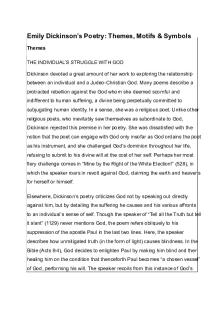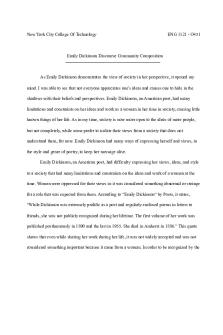Poem analysis of “ ‘Hope’ Is The Thing With Feathers” by Emily Dickinson PDF

| Title | Poem analysis of “ ‘Hope’ Is The Thing With Feathers” by Emily Dickinson |
|---|---|
| Course | Engelska 7 |
| Institution | Gymnasieskola (Sverige) |
| Pages | 3 |
| File Size | 94.6 KB |
| File Type | |
| Total Downloads | 90 |
| Total Views | 127 |
Summary
Download Poem analysis of “ ‘Hope’ Is The Thing With Feathers” by Emily Dickinson PDF
Description
Poem analysis of “ ‘Hope’ Is The Thing With Feathers” Emily Dickinson is today widely considered to be one of the most preeminent American poets of the nineteenth century. She wrote approximately 1,800 poems, however less than a dozen were published and only recognized after her lifetime. Dickinson was born December 10, 1830, in Amherst, Massachusetts. She rarely left her house in Amherst and lived in almost complete disengagement from the world outside, maintaining some certain associations through letters. Throughout her poetry we get a comprehension and understanding about the inner struggles she faced within herself as she lived in seclusion and started to question religion, God and her faith. However she nonetheless expresses also feelings of optimism and conveys her more realistic thoughts with themes and symbolism of nature as well as the prevailing human situation. Within this poem analysis I will discuss and prove my thesis that Emily Dickinson writes her most famous poem “ ‘Hope’ is the thing with feathers” in the style characteristic of the Victorian era and contains plenty of similar components. “ ‘Hope’ is The Thing with Feathers” is one of the most well known poems written by Emily Dickinson and published by her sister in 1891. Dickinson displays through her poem the meaning of hope and how it lends its hand to us during times of prosperity as well as during adversity. Hope is displayed as a bird that dwells within our soul, “That perches in the soul -”.The metaphorical image of hope as a bird never asks for anything in return and consistently lives within us, keeping us warm and providing solace. Dickinson applies an abstract idea which is “Hope” and connects it to something apparent and visible as well as something we can imagine and is tangible. With her poem Dickinson wants to accentuate the significance of staying optimistic and hopeful. The bird is explained as one of our most prerequisite and valuable quality. Dickinson’s poem structure consists of a rhyming scheme of "abcb.". The poem contains three stanzas and in every stanza the second and fourth line rhymes with each other. For example in the second stanza where “And sore must be the storm -” rhymes with the fourth line “That kept so many warm -”. The poem also alternates amid iambic tetrameter and iambic trimeter. Iambic tetrameter is displayed in the first and third lines of the poem while the iambic trimeter is presented in the second and fourth line. An Iamb is a pattern where the first syllable is unstressed while the second syllable is instead stressed, usually in a two-syllable pair. You will find an nd sings the tune iambic tetrameter that is composed of four iambs for instance in the line, “ A without the words”. The iambic feet contribute with a consistent and steady sound with indicated short pauses as well as a gentle tone making it easier to read. The poems contain also plenty of hyphens, this gives the effect and feeling of a continuing story and joins all lines together creating a soothing and slow flow.
Literary devices are often used by writers to make us feel a certain way and can vary depending on what the writer wants to convey. In Dickinson’s poem “ ‘Hope’ is The Thing with Feathers” we encounter an assortment of varying literary devices. The most eminent device used is extended metaphor. Metaphor is a device employed predominantly in order to make a comparison between two things to show concealed resemblance. In Dickinson's poem we are confronted with the most prominent metaphor, the comparison of hope to a bird. Dickinson writes regarding the abstract feeling hope in the matter of comparing it to something we can visualize, such as the physical entity of a bird. “ ‘Hope’ is The Thing with Feathers” and “That perches in the soul -” are two example of the many metaphors in the poem that elucidate the feeling of hope. The use of metaphors in the poem is of great significance since it helps the reader understand and visualize hope and also allows the poet to create their own interpretation of the feeling and put it into terms that anyone is able to comprehend. Personification is a often used literary tool and is when something inanimate, often an object or feeling, is given human traits or characteristics. In the poem Dickinson assigns the emotion hope, represented as bird, with the qualities of a human. Hope through the poem is able to sing, fly and ask, “It asked a crumb - of me.” and the storm is described as sore. The use of personification throughout the poem is applied to describe something hard to see and understand. Personification in Dickinson’s poem gives hope a profound meaning and includes vividness to new expressions that we humans can picture and also manage to do. Dickinson wishes to paint a picture in our mind and help us see her own perspective in hope, how it feels and its curtail boundaries. During a period of misery, anguish and animosity often occuring during the Victorian era, she desire to remind the people about hope and how we all have it within us. I have analysed the poem by looking through the authors past, the content and structure of the poem as well as the literary devices accommodated and reach a conclusion that proof my thesis that the poem “ ‘Hope’ is The Thing with Feathers'' by Emily Dickinson encompass the characteristics of the victorian era. During the era, 1837-1901, the use of sensory components became a frequent theme found in numerous poems where many contained the usage of symbolism and metaphors to express the struggles between religion and science as well as the new prospect on romance and nature. The era accommodated a period where many people started to doubt God, including Dickinson herself, because of the publication of Charles Darwin theory on evolution and the increasing development of rationalism, empirical science and radicalism. Literature written during the era contains plenty of questions about life and feelings like uncertainty but also hope. During this era poets sought to express the period’s social turmoil through the element realism which concentrates on the meticulous representation of life's details. Most of these thoughts and writing techniques can be deciphered and observed in Dickinson’s poem
“Hope” is the thing with feathers By Emily Dickinson “Hope” is the thing with feathers That perches in the soul And sings the tune without the words And never stops - at all And sweetest - in the Gale - is heard And sore must be the storm That could abash the little Bird That kept so many warm I’ve heard it in the chillest land And on the strangest Sea Yet - never - in Extremity, It asked a crumb - of me. To Include: About the author, content, structure, literary devices and conclusion....
Similar Free PDFs

Emily Dickinson - notes
- 6 Pages

poesie di emily dickinson 1
- 1 Pages

Analysis of the poem Reapers
- 3 Pages

Poem Analysis
- 4 Pages
Popular Institutions
- Tinajero National High School - Annex
- Politeknik Caltex Riau
- Yokohama City University
- SGT University
- University of Al-Qadisiyah
- Divine Word College of Vigan
- Techniek College Rotterdam
- Universidade de Santiago
- Universiti Teknologi MARA Cawangan Johor Kampus Pasir Gudang
- Poltekkes Kemenkes Yogyakarta
- Baguio City National High School
- Colegio san marcos
- preparatoria uno
- Centro de Bachillerato Tecnológico Industrial y de Servicios No. 107
- Dalian Maritime University
- Quang Trung Secondary School
- Colegio Tecnológico en Informática
- Corporación Regional de Educación Superior
- Grupo CEDVA
- Dar Al Uloom University
- Centro de Estudios Preuniversitarios de la Universidad Nacional de Ingeniería
- 上智大学
- Aakash International School, Nuna Majara
- San Felipe Neri Catholic School
- Kang Chiao International School - New Taipei City
- Misamis Occidental National High School
- Institución Educativa Escuela Normal Juan Ladrilleros
- Kolehiyo ng Pantukan
- Batanes State College
- Instituto Continental
- Sekolah Menengah Kejuruan Kesehatan Kaltara (Tarakan)
- Colegio de La Inmaculada Concepcion - Cebu











![I Killed Her [ A Poem ] - a poem inspired by the declamation piece with the same title.](https://pdfedu.com/img/crop/172x258/oz3ld1w1gn2w.jpg)